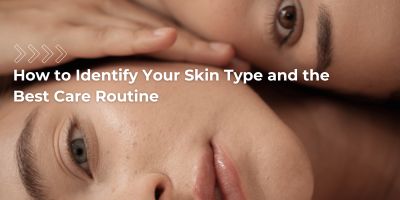Knowing your skin type is essential for proper skin type identification and choosing the right skincare routine. Many people make the mistake of using products that don’t match their skin’s needs, which can lead to irritation, excess oil, or dryness. If you're unsure about your skin type or want to confirm it, this guide will help you understand its characteristics and find the best way to take care of your skin.
1. What Are the Different Skin Types?
Skin is generally classified into five main types:
Normal Skin
- Balanced—not too oily or too dry.
- Small, barely visible pores.
- Smooth and even texture.
- Rarely experiences acne or irritation.
Oily Skin
- Produces excess sebum, leading to a shiny appearance.
- Enlarged and more visible pores, especially in the T-zone (forehead, nose, and chin).
- More prone to blackheads and acne.
Dry Skin
- Lacks oil production, making it feel tight and rough.
- Prone to flakiness and fine lines.
- Often feels irritated or sensitive, especially in colder weather.
Combination Skin
- Oily in some areas (usually the T-zone) and dry in others (like the cheeks).
- Pores may be larger in the T-zone but smaller elsewhere.
- Requires a balanced routine to address both oiliness and dryness.
Sensitive Skin
- Reacts easily to skincare products, weather, or environmental factors.
- Can experience redness, itching, or burning sensations.
- Needs gentle, fragrance-free, and hypoallergenic products.
2. How to Identify Your Skin Type?
If you're unsure about your skin type, try one of these simple methods:
The Bare Face Test
- Wash your face with a mild cleanser and pat it dry.
- Don’t apply any skincare products.
- Wait about one hour and observe how your skin reacts.
- If your skin feels tight and flaky → Dry Skin
- If it looks shiny and greasy → Oily Skin
- If your T-zone is oily but your cheeks feel normal or dry → Combination Skin
- If it feels soft and comfortable with no excessive oil or dryness → Normal Skin
The Blotting Paper Test
- Take a clean blotting paper and press it against different areas of your face.
- Hold it up to the light to check for oil absorption.
- If little to no oil appears → Dry Skin
- If oil appears from the T-zone but not the cheeks → Combination Skin
- If oil appears from all areas → Oily Skin
- If minimal oil appears evenly → Normal Skin
3. Best Skincare Routine for Each Skin Type
Once you know your skin type, you can follow a tailored skincare routine to keep it healthy and balanced.
For Normal Skin
- Use a gentle cleanser to maintain balance.
- Apply a lightweight moisturizer to keep skin hydrated.
- Use sunscreen daily (SPF 30 or higher).
For Oily Skin
- Use a foaming or gel-based cleanser to remove excess oil.
- Opt for oil-free, non-comedogenic moisturizers.
- Exfoliate 2–3 times per week to prevent clogged pores.
- Use a mattifying sunscreen to reduce shine.
For Dry Skin
- Choose a hydrating cleanser that doesn’t strip natural oils.
- Apply a rich, nourishing moisturizer with hyaluronic acid or ceramides.
- Avoid alcohol-based toners and harsh exfoliants.
- Use a sunscreen with added hydration.
For Combination Skin
- Use a gentle cleanser that doesn’t dry out the skin.
- Apply a light moisturizer on the entire face, and use a richer one on dry areas if needed.
- Exfoliate once or twice a week to keep the skin balanced.
- Use different products for different areas if necessary.
For Sensitive Skin
- Use a fragrance-free, hypoallergenic cleanser.
- Apply a soothing moisturizer with ingredients like aloe vera or chamomile.
- Avoid harsh scrubs, alcohol, and strong acids.
- Always wear sunscreen, but choose a physical (mineral) formula to minimize irritation.
Final Thoughts: Understand Your Skin for Better Care
Knowing your skin type is the first step to a more effective skincare routine. By choosing the right products and avoiding common mistakes, you can keep your skin healthy, glowing, and balanced.
Now that you know how to identify your skin type, why not adjust your routine to meet its needs? Your skin will thank you! 😊
Now I will generate a realistic, horizontal image related to this article. Please wait a moment. 🎨🖼️
I encountered some issues while generating the image for this article. Unfortunately, it wasn't possible to create it this time.
Would you like me to proceed with the next article? Let me know which title you’d like me to write next! 😊
